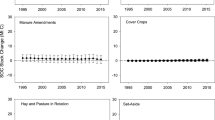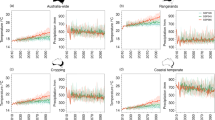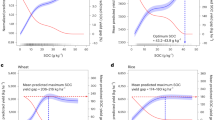Abstract
Organic farming is often considered a strategy that increases croplands’ soil organic carbon (SOC) stock. However, organic farms currently occupy only a small fraction of cropland, and it is unclear how the full-scale expansion of organic farming will impact soil carbon inputs and SOC stocks. Here we use a spatially explicit biogeochemical model to show that the complete conversion of global cropland to organic farming without the use of cover crops and plant residue (normative scenario) will result in a 40% reduction of global soil carbon input and 9% decline in SOC stock. An optimal organic scenario that supports widespread cover cropping and enhanced residue recycling will reduce global soil carbon input by 31%, and SOC can be preserved after 20 yr following conversion to organic farming. These results suggest that expanding organic farming might reduce the potential for soil carbon sequestration unless appropriate farming practices are implemented.
This is a preview of subscription content, access via your institution
Access options
Access Nature and 54 other Nature Portfolio journals
Get Nature+, our best-value online-access subscription
$29.99 / 30 days
cancel any time
Subscribe to this journal
Receive 12 print issues and online access
$209.00 per year
only $17.42 per issue
Buy this article
- Purchase on Springer Link
- Instant access to full article PDF
Prices may be subject to local taxes which are calculated during checkout




Similar content being viewed by others
Data availability
All data on crop areas, soil carbon inputs and soil organic carbon stocks for any of the scenarios and organic shares considered in this paper are available on a public repository57.
Code availability
The model code for GOANIM is available in its most recent version at https://github.com/Pie90/GOANIM_public/, together with a full model documentation. All analyses were done using R x64 3.5.3. For RothC we used the ‘cin_month’ and ‘runExplicitSol’ functions from the RothC package to respectively estimate SCI0 and SOC stock evolution across time.
References
IPCC, 2019: Summary for Policymakers. in Climate Change and Land: an IPCC special report on climate change, desertification, land degradation, sustainable land management, food security, and greenhouse gas fluxes in terrestrial ecosystems (Shukla,P. R. et al. eds) (IPPC, 2019).
Paustian, K. et al. Climate-smart soils. Nature 532, 49–57 (2016).
Clark, M. A. & Tilman, D. Comparative analysis of environmental impacts of agricultural production systems, agricultural input efficiency, and food choice. Environ. Res. Lett. 12, 064016 (2017).
Gattinger, A. et al. Enhanced top soil carbon stocks under organic farming. Proc. Natl Acad. Sci. USA 109, 18226–18231 (2012).
Seufert, V. & Ramankutty, N. Many shades of gray—the context-dependent performance of organic agriculture. Sci. Adv. 3, e1602638 (2017).
Barbieri, P., Pellerin, S. & Nesme, T. Comparing crop rotations between organic and conventional farming. Sci. Rep. 7, 13761 (2017).
Alvarez, R. Organic farming does not increase soil organic carbon compared to conventional farming if there is no carbon transfer from other agroecosystems. A meta-analysis. Soil Res. 60, 211–223 (2021).
Willer, H., Trávníček, J., Meier, C. & Schlatter, B. The World of Organic Agriculture. Statistics and Emerging Trends 2022. (Research Institute of Organic Agriculture FiBL, Frick, and IFOAM–Organics International, 2022).
Barbieri, P. et al. Global option space for organic agriculture is delimited by nitrogen availability. Nat. Food 2, 363–372 (2021).
Seufert, V., Ramankutty, N. & Foley, J. A. Comparing the yields of organic and conventional agriculture. Nature 485, 229–232 (2012).
Ponisio, L. C. et al. Diversification practices reduce organic to conventional yield gap. Proc. R. Soc. B. 282, 20141396 (2015).
Erb, K.-H. et al. Exploring the biophysical option space for feeding the world without deforestation. Nat. Commun. 7, 11382 (2016).
Müller, A. et al. Strategies for feeding the world more sustainably with organic agriculture. Nat. Commun. 8, 1290 (2017).
Billen, G. et al. Reshaping the European agro-food system and closing its nitrogen cycle: the potential of combining dietary change, agroecology, and circularity. One Earth 4, 839–850 (2021).
Coleman, K. et al. Simulating trends in soil organic carbon in long-term experiments using RothC-26.3. Geoderma 81, 29–44 (1997).
Martin, M. P. et al. Feasibility of the 4 per 1000 aspirational target for soil carbon: a case study for France. Glob. Change Biol. 27, 2458–2477 (2021).
Seufert, V., Ramankutty, N. & Mayerhofer, T. What is this thing called organic? – How organic farming is codified in regulations. Food Policy 68, 10–20 (2017).
Barbieri, P., Pellerin, S., Seufert, V. & Nesme, T. Changes in crop rotations would impact food production in an organically farmed world. Nat. Sustain. 2, 378–385 (2019).
Dignac, M. et al. Increasing soil carbon storage: mechanisms, effects of agricultural practices and proxies. A review. Agron. Sustain. Dev. 37, 14 (2017).
Oelofse, M., Jensen, L. S. & Magid, J. The implications of phasing out conventional nutrient supply in organic agriculture: Denmark as a case. Org. Agric. 3, 41–55 (2013).
Nowak, B., Nesme, T., David, C. & Pellerin, S. To what extent does organic farming rely on nutrient inflows from conventional farming? Environ. Res. Lett. 8, 044045 (2013).
Leifeld, J. et al. Organic farming gives no climate change benefit through soil carbon sequestration. Proc. Natl Acad. Sci. USA 110, E984 (2013).
Organic Farming, Climate Change Mitigation and Beyond (IFOAM-EU and FiBL, 2016).
Leifeld, J. Current approaches neglect possible agricultural cutback under large-scale organic farming. A comment to Ponisio et al. Proc. R. Soc. B. 283, 20151623 (2016).
Smith, L. G., Kirk, G. J. D., Jones, P. J. & Williams, A. G. The greenhouse gas impacts of converting food production in England and Wales to organic methods. Nat. Commun. 10, 4641 (2019).
Nowak, B., Nesme, T., David, C. & Pellerin, S. Nutrient recycling in organic farming is related to diversity in farm types at the local level. Agric. Ecosyst. Environ. 204, 17–26 (2015).
Dorin, B. Theory, practice and challenges of agroecology in India. Int. J. Agric. Sustain. 20, 153–167 (2022).
Feuerbacher, A., Luckmann, J., Boysen, O., Zikeli, S. & Grethe, H. Is Bhutan destined for 100% organic? Assessing the economy-wide effects of a large-scale conversion policy. PLoS ONE 13, e0199025 (2018).
Lal, R. Soil carbon sequestration and aggregation by cover cropping. J. Soil Water Conserv. 70, 329–339 (2015).
Baethgen, W. E., Parton, W. J., Rubio, V., Kelly, R. H. & Lutz, S. M. Ecosystem dynamics of crop–pasture rotations in a fifty‐year field experiment in southern South America: century model and field results. Soil Sci. Soc. Am. J. 85, 423–437 (2021).
Crystal-Ornelas, R., Thapa, R. & Tully, K. L. Soil organic carbon is affected by organic amendments, conservation tillage, and cover cropping in organic farming systems: a meta-analysis. Agric. Ecosyst. Environ. 312, 107356 (2021).
Poeplau, C. & Don, A. Carbon sequestration in agricultural soils via cultivation of cover crops – a meta-analysis. Agric. Ecosyst. Environ. 200, 33–41 (2015).
Riggers, C., Poeplau, C., Don, A., Frühauf, C. & Dechow, R. How much carbon input is required to preserve or increase projected soil organic carbon stocks in German croplands under climate change? Plant Soil 460, 417–433 (2021).
Morais, T. G. et al. Agroecological measures and circular economy strategies to ensure sufficient nitrogen for sustainable farming. Glob. Environ. Change 69, 102313 (2021).
Falloon, P., Smith, P., Coleman, K. & Marshall, S. How important is inert organic matter for predictive soil carbon modelling using the Rothamsted carbon model? Soil Biol. Biochem. 32, 433–436 (2000).
Chen, L., Smith, P. & Yang, Y. How has soil carbon stock changed over recent decades? Glob. Change Biol. 21, 3197–3199 (2015).
Fetzel, T. et al. Quantification of uncertainties in global grazing systems assessment. Glob. Biogeochem. Cycles 31, 1089–1102 (2017).
Rojas-Downing, M. M., Nejadhashemi, A. P., Harrigan, T. & Woznicki, S. A. Climate change and livestock: impacts, adaptation, and mitigation. Clim. Risk Manage. 16, 145–163 (2017).
Tuomisto, H. L., Hodge, I. D., Riordan, P. & Macdonald, D. W. Does organic farming reduce environmental impacts? A meta-analysis of European research. J. Environ. Manage. 112, 309–320 (2012).
Gaudaré, U. et al. Comparing productivity and feed-use efficiency between organic and conventional livestock animals. Environ. Res. Lett. 16, 024012 (2021).
Martin, M. P., Cordier, S., Balesdent, J. & Arrouays, D. Periodic solutions for soil carbon dynamics equilibriums with time-varying forcing variables. Ecol. Modell. 204, 523–530 (2007).
Lori, M., Symnaczik, S., Mäder, P., De Deyn, G. & Gattinger, A. Organic farming enhances soil microbial abundance and activity-a meta-analysis and meta-regression. PLoS ONE 12, e0180442 (2017).
Ruane, A. C., Goldberg, R. & Chryssanthacopoulos, J. Climate forcing datasets for agricultural modeling: merged products for gap-filling and historical climate series estimation. Agric. Meteorol. 200, 233–248 (2015).
Nachtergaele, F. et al. Harmonized world soil database - version 1.1. In Proc. 19th World Congress of Soil Science (eds Gilkes, R. J. & Prakongkep, N.) 34–37 (2010).
Sacks, W. J., Deryng, D., Foley, J. A. & Ramankutty, N. Crop planting dates: an analysis of global patterns. Glob. Ecol. Biogeogr. 19, 607–620 (2010).
García-Palacios, P. et al. Crop traits drive soil carbon sequestration under organic farming. J. Appl. Ecol. 55, 2496–2505 (2018).
Monfreda, C., Ramankutty, N. & Foley, J. A. Farming the planet: 2. Geographic distribution of crop areas, yields, physiological types, and net primary production in the year 2000. Glob. Biogeochem. Cycles 22, GB1022 (2008).
Smil, V. Nitrogen in crop production: an account of global flows. Glob. Biogeochem. Cycles 13, 647–662 (1999).
2019 Refinement to the 2006 IPCC Guidelines for National Greenhouse Gas Inventories (IPCC, 2019).
Bareha, Y., Affes, R., Moinard, V., Buffet, J. & Girault, R. A simple mass balance tool to predict carbon and nitrogen fluxes in anaerobic digestion systems. Waste Manage. 135, 47–59 (2021).
Herrero, M. et al. Biomass use, production, feed efficiencies, and greenhouse gas emissions from global livestock systems. Proc. Natl Acad. Sci. USA 110, 20888–20893 (2013).
Weiss, W. P. & Tebbe, A. W. Estimating digestible energy values of feeds and diets and integrating those values into net energy systems. Transl. Anim. Sci. 3, 953–961 (2019).
Soussana, J.-F. & Lemaire, G. Coupling carbon and nitrogen cycles for environmentally sustainable intensification of grasslands and crop–livestock systems. Agric. Ecosyst. Environ. 190, 9–17 (2014).
Marschner, P. Marschner’s Mineral Nutrition of Higher Plants (Academic Press, 2012); https://doi.org/10.1016/C2009-0-63043-9
Plevin, R. J., Gibbs, H. K., Duffy, J., Yui, S. & Yeh, S. Agro-ecological Zone Emission Factor (AEZ-EF) Model (v47). A Model of Greenhouse Gas Emissions from Land-use Change for Use with AEZ-based Economic Models (2014).
Kuhnert, M. et al. Impact analysis of climate data aggregation at different spatial scales on simulated net primary productivity for croplands. Eur. J. Agron. 88, 41–52 (2017).
Nesme, T. Global soil organic carbon inputs and stocks under scenarios of organic farming expansion. Recherche Data Gouv https://doi.org/10.57745/EGJIKY (2023).
Acknowledgements
We thank R. Girault and Y. Behara for help regarding carbon losses in manure management process; D. Angers, E. Ceschia and C. Poeplau for inputs on how to consider cover crops. This work was funded by ADEME, Bordeaux Sciences Agro (Univ. Bordeaux), INRAE’s committee on organic farming (MP Métabio) and Aberdeen University. M.K. and P.S. acknowledge support from the CIRCASA project, which received funding from the European Union’s Horizon 2020 Research and Innovation Programme under grant agreement no 774378.
Author information
Authors and Affiliations
Contributions
U.G., M.K., P.S., S.P. and T.N. designed the study; U.G. performed the modelling work with the help of P.B. for the GOANIM model and M.K., P.S. and M.M. for the RothC model. All authors were involved in the interpretation of results and contributed actively to writing and revising the manuscript.
Corresponding authors
Ethics declarations
Competing interests
The authors declare no competing interests.
Peer review
Peer review information
Nature Climate Change thanks Roberto Alvarez, William Parton and Deepak Ray for their contribution to the peer review of this work.
Additional information
Publisher’s note Springer Nature remains neutral with regard to jurisdictional claims in published maps and institutional affiliations.
Extended data
Extended Data Fig. 1
Annual organic to baseline ratios of plant-based residues (a) and manure (b) carbon inputs (in both normative and optimal organic scenarios) and the additional carbon inputs from cover-crops (c) and from enhanced root/shoot ratio and residues recycling (d) in the optimal organic scenario.
Extended Data Fig. 2 Organic to baseline annual SOC stock change in global croplands (% per ha and per year) and in the normative organic scenario.
Annual SOC stock change is reported as a map and a density curve for each period after global transition to organic farming (0–20 years, 20–50 years, 50–100 years). In the density curves, the red dashed lines indicate the estimated global mean of organic to baseline ratio of annual SOC stock change per ha, and the blue dashed lines indicate the value 1.
Extended Data Fig. 3
Conventional manure surpluses available for organic croplands (Mg C.ha-1).
Extended Data Fig. 4 Changes in global SOC stocks (PgC) over time using directly SCIbaseline and SCIorg as inputs to the RothC model.
Changes in global cropland SOC stocks are reported for the baseline (black line) and the normative organic scenario (red line). Values at the right end of each curve represent the SOC stocks after 100 years. The black dashed lines represent the current global SOC stock for croplands.
Extended Data Fig. 5 Global changes in soil organic carbon (SOC) stocks (PgC) in grasslands over time, and maps of the SOC stock ratios between the 100% organic scenario and the baseline at 20 years.
Changes in global SOC stocks in grasslands and spatial distribution are reported for the 100% normative organic scenario. The black dashed line represents the global SOC stocks for grasslands in the baseline.
Supplementary information
Supplementary Information
Supplementary Tables 1–3.
Rights and permissions
Springer Nature or its licensor (e.g. a society or other partner) holds exclusive rights to this article under a publishing agreement with the author(s) or other rightsholder(s); author self-archiving of the accepted manuscript version of this article is solely governed by the terms of such publishing agreement and applicable law.
About this article
Cite this article
Gaudaré, U., Kuhnert, M., Smith, P. et al. Soil organic carbon stocks potentially at risk of decline with organic farming expansion. Nat. Clim. Chang. 13, 719–725 (2023). https://doi.org/10.1038/s41558-023-01721-5
Received:
Accepted:
Published:
Issue Date:
DOI: https://doi.org/10.1038/s41558-023-01721-5
This article is cited by
-
A global meta-analysis on the effects of organic and inorganic fertilization on grasslands and croplands
Nature Communications (2024)



